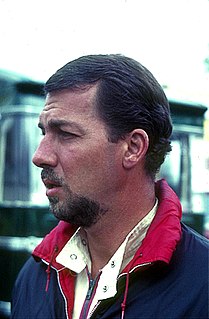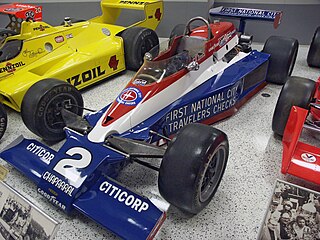Lola Cars International Ltd. was a British race car engineering company in operation from 1958 to 2012. The company was founded by Eric Broadley in Bromley, England, before moving to new premises in Slough, Buckinghamshire and finally Huntingdon, Cambridgeshire, and endured for more than fifty years to become one of the oldest and largest manufacturers of racing cars in the world. Lola Cars started by building small front-engined sports cars, and branched out into Formula Junior cars before diversifying into a wider range of sporting vehicles. Lola was acquired by Martin Birrane in 1998 after the unsuccessful MasterCard Lola attempt at Formula One.

Joakim Bonnier was a Swedish sportscar racing and Formula One driver who raced for various teams. He was the first Swede to both enter and win a Formula One Grand Prix.

Circuit Mont-Tremblant is a 4.26 km (2.65 mi) race circuit about 13 km (8.1 mi) south of the village of Mont-Tremblant, Quebec, Canada. The name of the village of Saint-Jovite was often included in the name of the circuit, but since the village was amalgamated into Mont-Tremblant in the year 2000, it is no longer considered or functions as an independent entity.
The Ferrari P was a series of Italian sports prototype racing cars produced by Ferrari during the 1960s and early 1970s.
Chaparral Cars was a pioneering American automobile racing team and race car developer that engineered, built, and raced cars from 1963 through 1970. Founded in 1962 by American Formula One racers Hap Sharp and Jim Hall, it was named after the roadrunner, a fast-running ground cuckoo also known as a chaparral bird.
Four-wheel drive (4WD) has only been tried a handful of times in Formula One. In the World Championship era since 1950, only eight such cars are known to have been built.

Ecurie Bonnier, Ecurie Suisse, Joakim Bonnier Racing Team and Anglo-Suisse Racing Team were names used by Swedish racing driver Joakim Bonnier to enter his own cars in Formula One, Formula Two and sports car racing between 1957 and his death in 1972. Commonly the vehicles were entered for Bonnier himself, but he also provided cars for a number of other drivers during the period.

The Lola T290, and its evolutions, the T292, T294, T296, T297, T298, and T299, are a series of Group 5 Sports 2000 prototype race cars, designed and developed by Bob Marston, John Barnard, Patrick Head, and Eric Broadley, and built by British manufacturer and constructor Lola, for European 2-Litre Championship sports car racing series, between 1972 and 1981.

The Lotus 69 was an open-wheel formula racing car developed by Lotus in 1969 for use in Formula 2, Formula 3, and Formula Ford.
The Lola T100 is a Formula 2 single-seater entered by German BMW team for the 1967 German Grand Prix, the seventh round of the 1967 Formula One World Championship. Designed by British manufacturer Lola Cars, led by engineer Eric Broadley, the T100 was raced by Britons David Hobbs and Brian Redman. A version adapted to the technical regulations of Formula 1 was also driven by German Hubert Hahne.

The Ligier JS2 is a mid-engined sports coupé that was built by Ligier in the French commune of Abrest near Vichy in the department of Allier between 1971 and 1975. Road-going and competition versions were built.

The Ligier JS3 is a sports-racing car that was built by Automobiles Ligier. It was unveiled in 1971 and ended its competition life in the same year. Only one JS3, chassis JS3-01, was ever built.
The Ligier JS1 is a sports-racing car that debuted in 1969 and was built by Automobiles Ligier. The car competed in various sportscar racing events during the 1969 and 1970 seasons.
The Lola T160 is a series of purpose-built Group 7 sports prototype race cars, designed and developed by British chassis manufacturer Lola Cars, specifically to compete in the Can-Am series in 1968. It was the successor to the competitive T70, sharing similar design knowledge and cues. Lola built the chassis, constructed out of fiberglass, and molded into an aluminum monocoque. This meant the car was light was lightweight, weighing only 670 kg (1,480 lb). The chassis was designed to accept a small-block engine, but most cars were powered by either the Chevrolet ZL1 or the Ford FE "big-block" motors, generating about 625–750 hp (466–559 kW); mated to a 4-speed or 5-speed Hewland L.G.500 or L.G.600 manual transmission. This made the cars very fast, with a notably excellent power-to-weight ratio. It was used in active competition until 1971, and was succeeded and used alongside the new T220 in 1970.
The Surtees TS5 was a Formula 5000 racing car, designed, developed, and built by Surtees between 1969 and 1970.

The Chevron B16 was a Group 4 sports prototype race car, designed, developed, and built in 1969 by the British racing car manufacturer Chevron Cars as a two-seater racing sports car for the makes world championship. Brian Redman won the very first outing, the 500 km (310 mi) race at the Nürburgring on September 7, 1969, at a time of 3:13:01.6 hours. The last victory with a Chevron B16 was achieved by Clemens Schickentanz on July 11, 1971, in the sports car race at the Norisring.

The Lola T500 is an open-wheel racing car chassis, designed, developed and built by Lola Cars, that competed in the CART open-wheel racing series, for competition in the 1978, 1979, and 1980 USAC Championship Car seasons. It was powered by the 840 hp (630 kW) Ford-Cosworth DFX. Only 5 models were produced. It won a total of 3 races, all in 1978, including the famous and prestigious 1978 Indianapolis 500, being driven by Al Unser.
The Lola B01/00 is an open-wheel racing car chassis, designed and built by Lola Cars that competed in the CART open-wheel racing series, for competition in the 2001 season. It scored a total of 10 race wins that season, with Swede Kenny Bräck eventually finishing in second place, as runner-up in the championship, with 163 points in this car.
The Lola T220, and its evolution, the Lola T222, are Group 7 sports prototype race cars, designed, developed, and built by the British manufacturer and constructor Lola, to compete in the Can-Am championship from the 1971 season. It also took part in the European Interserie championship.

The Lola T280, and its evoltuions, the Lola T282, Lola T284, and Lola T286, are a series of 3-liter Group 5 (and later Group 6 sports prototype race cars, designed by Eric Broadley, John Barnard, and Patrick Head, and developed and built by British manufacturer and constructor Lola, for World Sportscar Championship sports car racing, between 1972 and 1976.












